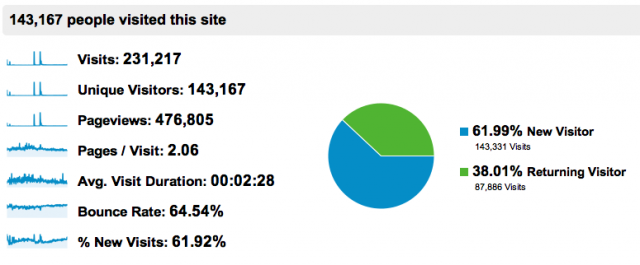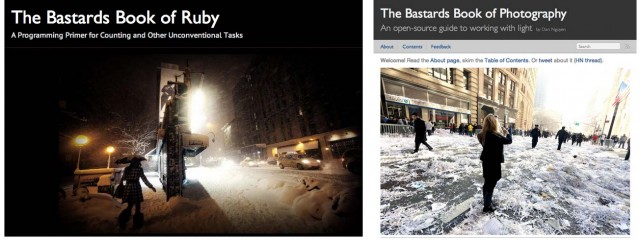
The majority of this photo’s Flickr pageviews comes from the Meet Your Web Inspector chapter, probably from readers who click the photo to see what exactly the hell is going on. Here’s the story: One day, a queen bee decided to take residence on a Chinatown mailbox. Her hive decided to follow her, causing the city to block off the corner so the bee inspectors could pluck her out. My friend from China who was visiting NYC for the first time said to me later that this was the most exciting thing she saw in New York all week. Coincidentally, the web inspector chapter is probably the most useful part (for beginners) of my programming book.
Last year, I wanted programming to be more accessible. So I published a rough draft of what I called the “Bastards Book of Ruby” and then never added to it again. It’s interesting to see how much actual traction it got. Here’s a screenshot of the Google Analytics visitors overview:
Caveat: Unfortunately, I never figured out how to get Google Analytics to do multiple subdomains, so this report includes the July traffic boost from the Bastards Book of Photography, which, day-to-day, is not as popular as the Ruby book.
In absolute terms, fewer than half a million pageviews in a year is not impressive for a free website (this 2 min. video I took of some guys playing Super Mario Brothers in the subway is already at 250K visits). But given that it’s a book about programming and that each single page consists of a “chapter” and is – in retrospect – way too long (the Ruby book is about 75,000 words altogether), I’ll pretend that they’re more “substantial” page views. At least a few visitors saved pages for offline viewing and really, after you’ve gone through the chapters you care about, there’s not much reason to return to the book since I never really updated it.
However, according to the % New Visits metric, there’s been a steady increase in percentage of new visitors:
Some traffic high points:
- 12/5/2011 – Bastards Book of Ruby is released. It made it to Hacker News’s front page: 11,566 pageviews
- 12/22/2011 – Once in awhile, either me or someone else would submit individual chapters to various sites. The chapter I had about scraping the Putnam County Sheriff’s Office got a few upvotes on HN: 6,528 pageviews
- 5/16/2012 – The Ruby book makes it to the top of HN, possibly in response to Jeff Atwood’s “Please Don’t Learn to Code” published the day before: 38,359 pageviews
- 6/21/2012 – The Bastards Book of Photography is published. It took me about two weeks to put together and I wanted to try out Octopress as a CMS to replace the hack Rails-to-static-file system I wrote for the Ruby book. It made the front of HN as well as Reddit’s photography and howto subreddits: 45,519
In the last few months, the average number of visitors per week ranges from 3,000 to 4,000 visitors.
Promotional work and referrals
The BBoR was aimed toward journalism professionals trying to learn coding but didn’t formally pitch it outside of Twitter, listing it on my online bios and mentioning it on the NICAR mailing list. Other hacker journalists were kind enough to give it a few shout-outs.
Most of the referrals overall came from technical audiences such as Hacker News and Reddit’s technical subreddits (again, the photo book numbers are mixed in here, which I think accounts for most of the social media traffic):
- news.ycombinator.com 38,817
- reddit.com 16,297
- t.co 7,062
- petapixel.com 6,372
- facebook.com 4,630
- danwin.com 3,704
- google.com 2,540
- citizen428.net 2,476
- news.ycombinator.org 1,348
- wired.com 1,015
The most-read topics
The most popular section of the Ruby book is the five-chapter-series I wrote on web scraping, which is of particular interest to journalists dealing with cruddy government websites that will never have an API. The Parsing HTML with Nokogiri is the most popular individual chapter.
In my own cookie-wiped Google Search, the book is the top result for “ruby web scraping”.
Here are the top 20 search terms that don’t include the word “bastard”. Apparently the Bastards Book doesn’t rank high at all for any photography search terms:
- alter positions in a list ruby
- ruby io safe io video stream
- parse image path with ruby
- putnam county jail log
- ruby mechanize
- nokogiri
- ruby web crawler
- `
- ruby if else
- web scraping ruby
- finding curly bracket special characters in excel
- ruby nokogiri
- ruby collections
- ruby parse html
- ruby web scraping
- text editor using wrong version of ruby
- nokogiri book
- ruby open html
- how to run a saved program in ruby
- ruby inline if
General interest in programming
Besides fixing typos and errors, I never did fulfill the promise of making major updates (to either of the books) this year and I’ve rarely mentioned the book after its first month – except in discussions about journalism and programming, which are pretty rare in general. To my surprise though, daily traffic has been generally steady. As I mentioned earlier, the two books receive about 3 to 4 thousand visitors weekly. When the Ruby book peaked on Hacker News in May, the average jumped from 1,500 visitors to 2,500 visitors. The current average has been the status quo since the photo book was released in July.
It would seem that the photo book accounts for the majority of the difference. But anecdotally, I get thank-you emails and tweets every week about the Ruby book and almost never hear feedback on the photo book. Sure, there are plenty of in-depth photography guides in comparison to programming books. But there’s far fewer aspiring programmers than photographers.
I hope to help change that and so have been working on a major update to the BBoR (including converting it to PDF form, probably the most requested feature). Earlier than later, hopefully, and as my off-work hours permit.
Sometime after March 2011 was when I started thinking about writing a programming book. This was after I had tried teaching the first learn-to-code class at General Assembly, an 8PM Thursday class called: “Coding for Beginners: Data Mashing with APIs”. Here’s the description I wrote up for the class:
Students will learn the fundamentals of programming by creating simple yet powerful scripts to collect and organize the data found in Web services such as Twitter, Google Maps, and Foursquare. The class will walk through sample Ruby code to understand the basic theory of programming, including variables, methods, arrays and loops. At the end, students will be able to write a fully-functional custom script to access and scrape website data.
This class is intended for absolute newbies and those beginning to learn how to code. Laptops are optional. Code for the lesson will be provided so that students can follow along during class and after. Prerequisites: None.
(Before you spit out your coffee, I do reflect below about how hilariously absurd this synopsis is, in retrospect)
Jenny 8. Lee at Hacks/Hackers) introduced me to GA but I remember the GA coordinator and I both thinking, “Who the hell actually wants to learn basic programming?” I don’t know what the average price for a GA class was then. But I know when we set the price at $30 for a 2-3 hour class, I thought it was too high and we’d end up with a pretty bare turnout.
And I was wrong: it was the fastest-selling class in GA’s then-young history and sold out in a day. And thankfully, the interest doesn’t seem to be a fluke: GA today regularly holds beginners’ programming classes, ranging from price of $175 for an afternoon to $3,000 for an eight-week Rails course (including Ruby fundamentals).
My own class didn’t go terribly well because, as I’ve found out since then, it’s kind of difficult to cover in 3 hours the programming fundamentals (variables/methods/if statements/for-loops in order to create a mashup from Twitter and Foursquare APIs) that it takes real teachers a semester to cover, especially to an audience mostly unfamiliar with the command line.
So the Ruby book was an attempt to create a resource that might actually be helpful for aspiring coders. Less than half a million pageviews might not much. But it’s been gratifying to see the Ruby book continue to be used even in its messy draft form by beginners who are incredibly committed to learning new things in life. I hope the next revision of the Ruby book will be even more useful to them.
Other resources: Who knows when I’ll actually finish. In the meantime, a lot of great programming resources have come out this past year, too many to list so I’ll just point out the Ruby ones. Free resources include Zed Shaw’s Ruby version of his Learn to Code the Hard Way and Codecademy’s Ruby track. Sau Sheong Chang’s Exploring Everyday Things with R and Ruby is one of my favorite books I’ve bought this year and it follows a philosophy similar to mine: use code to do creative, real-world problem solving.



